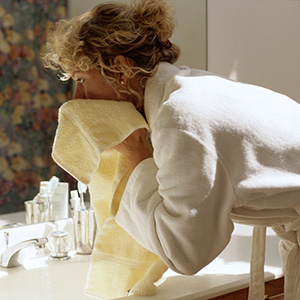by Linda Leibl —

“The FDA can take action on a case in which harm is done only after a product is on the market and only after it has received enough consumer complaints and enough evidence has been collected to prove in court that the product is hazardous.” — Debra Lynn Dadd in Home Safe Home
I am always amazed at the number of people I meet who are unaware that much of our food is toxic — full of antibiotics, hormones, artificial preservatives, pesticides, fillers, additives and dyes. While you might already be cognizant of this, what you may not know is that the same holds true for your skincare items. Many of the items sitting on your bathroom shelf may be seriously harmful to you and your family, including cosmetics, hair products, body lotions and even baby care products.
Are you aware that 98 percent of the cosmetics industry markets and promotes harmful ingredients that may contain carcinogens?
The good news is that you can do a great deal to help yourself, your family and your loved ones create longevity, better health and happiness. You have the power to take charge, change, improve and even save the lives of those around you. You can become proactive today.
Clean out those shelves
The cosmetics industry has become so big and, in many cases, the products so powerful, that the word cosmeceutical is now used to refer to the products that produce drug-like effects. While many of these products do indeed contain powerful ingredients, it is important to know that they are, for the most part, unregulated and untested.
It also is important to know where and what to look for in these ingredients. Cosmeceuticals are commonly found in skin exfoliators, skin-peeling agents, skin lighteners and darkeners, and the like. One way to view it is, if a product changes the skin, then it is a drug, and most likely one that has not been tested for side effects or long-term effects. This puts the onus on the consumer to understand the precise short- and long-term effects of these ingredients on the body.
You should also be aware that most of these products simply do not work. Very few cosmetics and makeup lines can actually slow down the aging process. Cosmetics companies pour most of their money into expensive packaging and marketing to entice consumers to buy their products. What this means is that rather than paying for quality inside the bottle, you really are paying for the outside packaging.
Furthermore, you actually may be shortening your life by applying these harmful products to your skin, day in and day out. Many of the products contain harmful ingredients, which can dramatically affect your health when such products are repeatedly used for 10, 20, 30 years and longer.
It is imperative that you become familiar with common cosmetic ingredients that can be harmful to you and your family. Take the time to read labels, and discard any and all items that contain mineral oil, petroleum, petrolatum, lanolin, beeswax, chemical dyes, chemical fragrances, animal products or animal byproducts — or anything that sounds like a chemical or you find difficult to pronounce. Unfortunately, you may find yourself discarding the majority of your products, as 98 percent of cosmetics products sold contain the above-mentioned ingredients. These include products you’ve purchased in fine department stores, specialty shops, retail chains and even upscale salons and spas.
What you can do
Start by realizing that you, the consumer, must look out for yourself. Begin to educate yourself. Know what harmful ingredients to look for, and find a company you can trust that uses only safe, pure ingredients. Look for a company with their own research and development department that retains organic chemists, biologists and herbalists with higher degrees in their fields of expertise. Also look for naphoric technology, which utilizes products that penetrate into the skin’s cells, rather than just sitting on the surface.
To take it a step further, you can look for companies that perform thorough testing. Most cosmetic companies avoid expensive testing which may disprove their products’ efficacy.
In the long run, the choice clearly is yours. Take the time to learn about what you are putting on your face and body. Consider spending a little more money to invest in products that are pure, safe and provide the results you want.
To your health and happiness!
References:
- Dr. Rita Goad, Ph.D., Toxic Awareness Workshop. September 2002.
- Howard E. Lyman with Glen Metzer, Mad Cowboy (New York: Touchstone Books, 1998) p.11-13.
- Ruth Winter, M.S., A Consumer’s Dictionary of Cosmetic Ingredients. (New York: Three River Press, 1999) p.1-2.
Linda L. Leibl, B.S., has been a clinical esthetician since 1986 and founded Advanced Skin Technology in 1993 in Scottsdale, Ariz. She recently created the Anti-Aging Facial, a four-component facial. She works as an educator and District Manager with Arbonne International. mybeautifulskin.myarbonne.com, LindaL@myarbonne.com or 480-443-3445.
Reprinted from AzNetNews, Volume 24, Number 3, June/July 2005.





January 18, 2014
Beauty and Anti-aging, Chemical and Toxic Exposure, Environment, Skin